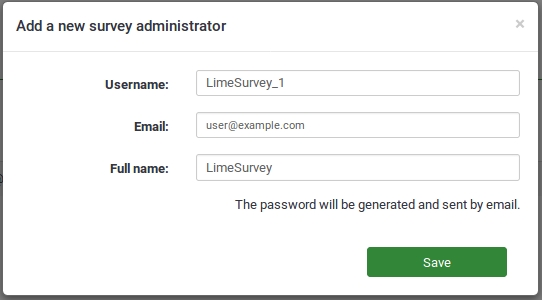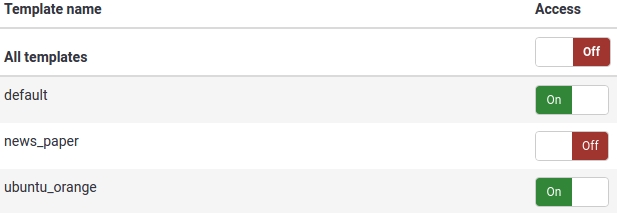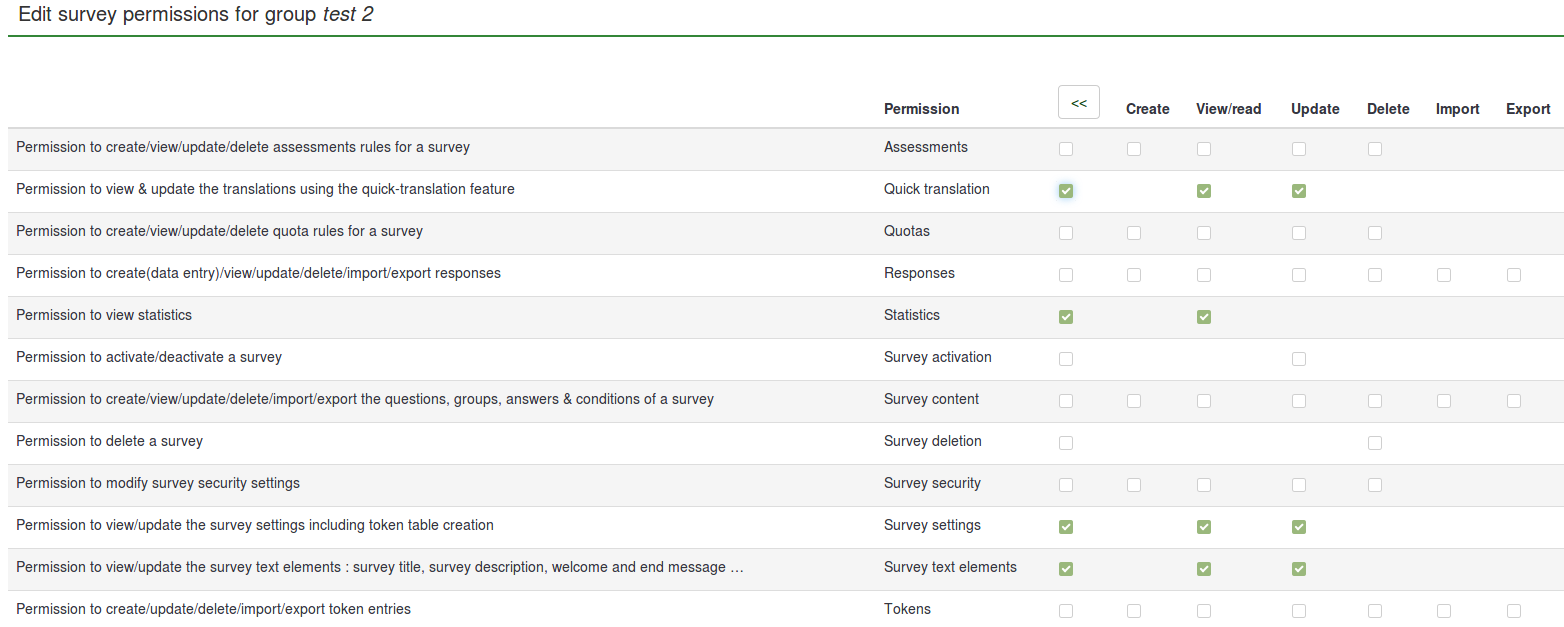Manage users/de: Difference between revisions
From LimeSurvey Manual
Surveyunihi (talk | contribs) No edit summary |
Surveyunihi (talk | contribs) No edit summary |
||
| Line 64: | Line 64: | ||
[[ | <center>[[File:User_global_permission.png]]</center> | ||
Revision as of 10:06, 13 June 2018
Benutzerverwaltung
Die Benutzerverwaltung ermöglicht es Ihnen, zusätzliche Administrations-Benutzer (Umfrageadministratoren) zu LimeSurvey hinzuzufügen. In diesem Abschnitt sollen diese einfach nur "Benutzer" genannt werden - nicht zu verwechseln mit den Umfrageteilnehmern.
Benutzer erstellen
Um einen neuen Benutzer anzulegen, muss in die Benutzer-Verwaltung (in der Hauptmenüleiste von LimeSurvey: Konfiguration -> Umfrageadministratoren verwalten ) gewechselt werden.
Klicken Sie dann auf Benutzer hinzufügen am linken Rand oberhalb der Tabelle der bereits existierenden Benutzer. (Benutzer-Administration). Es erscheint ein PopUp-Fenster, wo Sie folgendes tun können:
- Im Textfeld Benutzername wird der gewünschte Benutzername eingetragen.
- Im Textfeld E-Mail geben Sie die E-Mail-Adresse des Benutzers an. Beachten Sie dabei:
- LimeSurvey sendet nach dem Anlegen des Benutzers an diese E-Mail-Adresse eine Bestätigungs-E-Mail mit dem Link zum Umfrage-System, dem Benutzernamen und dem Passwort.
- Wenn Sie nicht möchten, dass der Benutzer selbst die Bestätigungs-E-Mail erhält, sollten Sie vorerst Ihre eigene E-Mail-Adresse eintragen. Dies kann später geändert werden.
- Diese Adresse wird ebenfalls als Standard-Kontaktadresse für Umfragen verwendet, die mit diesem Benutzer-Account erstellt werden.
- Im Textfeld Vollständiger Name können Vor- und Nachname des Benutzers eingetragen werden. Beachten Sie bitte, dass der Vollständige Name nicht nur intern angezeigt wird, sondern auch als Standard-Kontakt-Ansprechpartner für Umfragen verwendet wird, die mit diesem Benutzer-Account erstellt werden (und damit den Umfrage-Teilnehmern sichtbar wird).
- Mittels des Buttons Speichern wird der Benutzer hinzugefügt.

Nun wurde ein neuer Benutzer angelegt. Wie dem Benutzer verschiedene (globale) Berechtigungen zugewiesen werden, wird im weiteren Verlauf dieses Abschnitts erläutert.

Unterhalb der Spalte Aktion sehen Sie vier Buttons, mit denen Sie die folgenden Aktionen ausführen können:

- Stift-Symbol: Ändern der allgemeinen Einstellungen eines Benutzers
- Papierkorb-Symbol: Löschen des Benutzers aus der Benutzerdatenbank.
- Schloss-Symbol: Ändern der globalen Berechtigungen eines Benutzers.
- Stift und Schloss-Symbol: Ändern der Berechtigungen für Designvorlagen.
Benutzer bearbeiten: Allgemeine Einstellungen
Um die allgemeinen Einstellungen eines Benutzers zu bearbeiten, klicken Sie auf den Button mit dem Stift-Symbol:
Sie können die E-Mail-Adresse, den vollständigen Namen (Vor- und Nachname) sowie das Passwort ändern. Wenn Sie fertig sind, klicken auf "'Speichern"'.
Benutzer löschen
Um einen Benutzer (sein Benutzerkonto) zu löschen, klicken Sie einfach auf den Button mit dem Papierkorb-Symbol in der Zeile mit dem Benutzerkonto, das gelöscht werden soll.
Globale Berechtigungen für einen Nutzer setzen
Um globale Berechtigungen für einen Benutzer zu setzen klicken Sie einfach den Button mit dem Schloss-Symbol.

Das System verwendet CRUD-Berechtigungen (CRUD= Create, Read, Update und Delete), ebenso wie bei den Berechtigungen für einzelne Umfragen. Wenn Sie die erste Checkbox markieren, wird die ganze Zeile markiert. Sie können die Berechtigungen aber auch detaillierter konfigurieren.

You can now add or remove the following permissions:
- Participant panel: For more details, continue reading about the central participant database here.
- Label sets: Permission to create, view, update, delete, export, and import label sets. The label sets don't have specific permissions (unlike design templates).
- Settings & Plugins: With this permission a user can check data integrity, save the SQL database to an .sql file, manage global settings, view the PHP info in the global settings, and manage all plugins.
- Surveys: Gives access to all surveys. To allow a user to only create and manage their own survey, give the user the 'create' permission. A creator of a survey is the owner of the survey and will always be able to manage it. Remember that each survey can grant different permissions .
- Templates: It allows the user to use all the available design templates and edit all non-standard templates. A person with this right should have sufficient knowledge in terms of HTML, Javascript, and CSS. If a user is not familiar with these things and is supposed to use a specific design template, it would be better to only give him 'read' permission. Each template can have specific permissions.
- User groups: This permission allows a user to create/view/update/delete user groups.
- Users: A user can create, modify, and delete his own administration users with this permission. The newly created users cannot have higher permissions than the parent user. You will also not be able to edit users owned by other administration users. If this has to be done, then a Superadministrator permission has to be granted.
- Superadministrator: This permissions can only be added or removed by the user called admin and grants full permission to the whole LimeSurvey application.
- Use internal database authentication: This permission allows users to access LimeSurvey's panel via the authentication page (e.g. http://domain/admin/authentication/sa/login). If it is unchecked and the respective user tries to connect to LimeSuvey's panel, he will get the following error: 'Internal database authentication method is not allowed for this user'.
Set template permissions for a user
With template permissions, you can decide which design templates a user can select when creating or editing a survey. It might be a good idea to restrict the design templates a user can select in order to prevent unwanted use of design templates, which you might consider to not be suitable for a survey/questionnaire.
For example, if you have a specific design template for a group of users or customers, you might want to restrict their access to other templates to only make them use the template created for their purpose.
To set or edit the template permissions for a user, simply click the pen-and-lock symbol for design templates:

Select the design templates to which the respective user or user groups should have access. After you finished your selection or deselection, do not forget to hit the Save button: ![]() .
.
To get a proper understanding of this function, check the examples provided below.
Nutzung von Einmalpasswörtern
A user can call the LimeSurvey login at /limesurvey/admin and enter a username and a one-time password (which was previously written into the users table - column one_time_pw - by an external application).
To enable this login method, the line $use_one_time_passwords = false; has to be set 'true' in config.php (it is 'false' by default) .
Nutzung von Einmalpasswörtern
Seit Version 1.81 kann ein Nutzer den LimeSurvey-Login unter /limesurvey/admin aufrufen und einen Benutzernamen sowie ein Einmalpasswort, das zuvor von einer externen Anwendung in die Benutzertabelle von LimeSurvey geschrieben wurde, per URL übergeben.
Um diese Loginmethode nutzen zu können, muss eine Einstellung ($use_one_time_passwords = true;) in config.php vorgenommen werden.
Die URL muss die folgenden Parameter enthalten:
- username: Der Benutzername, mit dem sich der Benutzer standardmäßig bei LimeSurvey anmeldet. Dieser muss in der Tabelle users vorhanden sein.
- onepass: Das Passwort im Klartext, es wird dann mit dem in der Datenbank hinterlegten Passwort abgeglichen
Eine korrekte URL für einen Login mittels Einmalpasswort sieht wie folgt aus:
A valid URL to login using a one-time password will look like this:
Things to watch out for:
- To enable this login method, the line
$use_one_time_passwords = false;has to be settruein config.php (it is 'false' by default). - The passed username has to exist in LimeSurvey's users table.
- The one-time password (which can be set via an external application) has to be stored as MD5 hash in column one_time_pw of table users.
- (This should be ignored except "Both passwords have to match") The passed plain text password will be hashed using the sha256 function and will then be compared to the stored hash in column one_time_pw of table users. Both passwords have to match.
- After the first login with the one-time password, it gets deleted from the database. The user won't be able to log in anymore with that respective password a second time.
- My local LS system can't test the permissions with different accounts (my email password does not have a way to be connected).
Set permissions for a single survey
These permissions only apply for a single survey. If you want to set permissions for the whole system, you can use global permissions. These permissions can be offered either to a single user or to a user group.
To change the survey permissions, you have to select the Settings sidebar of your survey. Then, click on Survey permissions and choose to whom would you like to offer permissions. The rights can be offered either separately to specific users or to a user group.


Grant survey permissions to a user
In the next step, select the user that will receive survey rights and click Add user.

After you click Set survey permissions, the user's survey permissions matrix will be shown.

You can set in this matrix the user's survey permissions. Checking a box grants survey permissions to the respective user. If you click on a checkbox from the first column, all the rights of the corresponding line will be selected/removed.
Click on the double-right arrowhead to access the extended version of the matrix to choose specifically the actions that can be performed by a user. After you finished editing the survey permissions, click on the Save button, which is located in the upper right corner of the screen.
Some examples are provided below in order to help you get a better understanding of Limesurvey's survey permissions system.
Grant survey permissions to a user group
Click on add a user group and select the user group to which you would like to add the permission rights.

In the next step, select the permissions that you will allocate to the members of that user group. Do not forget to click on the double right arrowhead to get an extended view of the permissions matrix.

After you finished editing the survey permissions, click on the Save button, which is located in the upper right part of the screen.
Some examples are provided below in order to help you get a better understanding of the Limesurvey's survey permissions system.
Examples
Different scenarios are presented below. They provide some advice about which rights are necessary for some specific tasks and how they can be granted to the users.
I want to add a new person in charge for administrating LimeSurvey
- Log in as admin.
- Create a new user account.
- Grant that user the Superadministrator permission.
- Not necessary : Setting the template permissions (Superadministrator has all permissions for all templates).
- Not necessary : Setting the survey permissions (Superadministrator has all permissions for all surveys).
A new user wants to create his/her own surveys
- Log in as admin (or as a user that has the Superadministrator permission).
- Create a new user account.
- Set global permissions for that user to Create survey.
- Optional : Set template permissions - select which template(s) should be used by the user/user group.
The creator of a survey needs another person to edit his/her survey
- Log in as admin (or as a user that has the Superadministrator permission).
- Create a new user account.
- Set no global permissions for user.
- Set no template permissions for user.
- Set the survey permissions the way you want. If he/she should receive all the survey permissions, you can check the first box from each row. Otherwise, click on the double-right arrowhead to see the expanded matrix (upper right corner) and select only those rights you believe the respective user should have.
A person responsible for the survey wants to see the results of the survey and export them
- Log in as admin (or as a user that has the Superadministrator permission).
- Create a new user account.
- Set no global permissions for user.
- Set no template permissions for user.
- Set survey permissions to: Responses -> View/read and export, and Statistics: View/read.

I need help from two interns that can help me with the translation of my survey
- Log in as admin (or as a user that has the Superadministrator permission).
- Create n user accounts (where n is the number of translators).
- Create a user group called Translators and add the n accounts to this group.
- Go to the Survey permissions and click on Add a user group.
- If they only do translations, then offer them the Quick translation permission.